When It All Began
As early as 1687, records show, Henry Kelsey, a fur trader from Hudson Bay was one of the first white men to see and explore the Canadian Prairies. History also tells us that around 1743 the La Verendrye brothers explored the more southerly plains and in their travels must have crossed the prairies at or near this very area.
As settlements in Manitoba spread westwards, no doubt fur traders and buffalo hunters explored these parts and by 1880 a few settlers were coming to the North West Territories, then divided into the districts of Assiniboia and Saskatchewan to the east (these became the province of Saskatchewan), and Alberta and Athabasca to the west (these became the province of Alberta.)
The town of Saltcoats, as it was eventually to be named, was situated in the district of Assiniboia, in the southeasterly portion of the North West Territories.
After Confederation of 1867 the Dominion Government could see that expansion of this great country was necessary. There was only one direction to expand and that was toward the west.
Already a few settlers were moving west and because the land was not surveyed the settlers resided in areas as "squatters," claiming land wherever it was available or most suitable for occupation. The government could see difficulties in this type of settlement and decided to deal with it by passing the Free Lands Homestead Act of 1872. By this act a homesteader was given 1/4 section of land to occupy and improve by clearing wood growth, if any, and also breaking the sod where the land was open prairie.
The Dominion Government also realized that surveying had to be the first step in opening up the west to avoid the joint claims by settlers who would eventually arrive in great numbers from all corners of the world.
Quite a bit of the land in this area was purchased by land holding companies or the railway and later sold to the settlers as they arrived in Canada, usually Winnipeg.
The Survey
By 1881, the Dominion land surveyors had divided the eastern part of this province into townships. It was necessary to divide the land so that one could find the exact location of a quarter section, for the purpose of registering a homestead or fencing your land within your own boundaries.
A township consists of 36 sections, a section is a mile square. So every six miles in a westerly direction, you have one higher number, known as the range line; and every six miles in a northerly direction you have a line, known as the township line, each one a higher number; and then again numbered by a meridian line. The surveying crews would run a straight line at every mile they would dig four holes in the form of a square, throwing the dirt up as a mound in the center. In the center of this mound there was a driven square pin, or iron, with the number of the section, the township and the range and meridian, cut in Roman numerals with a chisel. You were always able to tell your exact location when you found one of these corner mounds.
In 1881, the Dominion surveyed a township of 36 sections which became Stirling Township. The first recorded settlers arrived in 1882 and homesteaded on the south end of a crescent-shaped lake. The town's name was changed from Stirling to Saltcoats. This name was chosen because the Allen Steamship Line's home port was Saltcoats, Scotland, which brought immigrants from the British Isles.
The following notes were recorded by T. Drummond in 1880 regarding Township #24:
"The surface on all the boundaries is the rolling prairie. The north is covered with thick scrub and some poplar bluffs and the soil is a fine gravelly loam; class 1, except near an alkaline lake in sections 35 and 36. On the west for the first four miles going north the soil is a rich clay loam, gravely in a few places, and the loand rates class 1. From thence it is class 2 and 3, the soil being gravelly and light. There are a good many scattered marshes. The east contains poplar bluffs, and occasional wet places where there is thick willow scrub. The soil is a rich clay loam; class 1."
A sub-division was surveyed in 1882 by J. J. Burrows his report recorded:
"There are two lakes and several creeks of good water, although a few ponds have an alkaline taste. The soil is a rich heavy clay loam. There is not much building timber."
Homesteading
A small number of settlers had arrived in the surrounding area early in 1882 but only a few remained throughout the winter. More arrived in the spring of 1883 having come by rail as far as Whitewood or Broadview, and then continuing either on foot or, if they were lucky, by oxen. The pace of the oxen, loaded or light, was about three miles an hour, and the oxen were said to be "as stubborn as any cow, and then some."
Consequently, many of the surrounding districts, or colonies as they were called, were settled in 1882-83, such as Kinbrae, Crescent Lake, Clumber, Perley, Boakeview, and Cut Arm. These very early colonies were almost entirely immigrants from the British Isles.
In the early days of the settlement of the prairies any male person 18 years of age or older could apply for a homestead; the application fee was $10.00 for a homestead, a quarter of land, 160 acres more or less.
The homesteader, in order to obtain the title to the land, was required to live on the property at least six months a year for three years and break a given number of acres of prairies sod. A son living with parents could apply for a homestead and fulfill the residence requirements while living with his parents, if in the same general area. Under certain circumstances a person who had completed the required duties on his homestead could apply for a second homestead.
The sections in any one township (36 sections) open for homesteading were confined to the even numbered sections, less section 8 and 3/4 of section 26 which parcels had been granted to the Hudson Bay Company when western Canada was taken over by the Dominion Government.
The odd numbered sections (with the exception of section 11 and 29 which were reserved for financing schools) were the property of the Canadian Pacific Railway Company as part of 25,000,000 acres granted to the Company as part of the deal entered into with the Dominion Government for construction of the C. P. Transcontinental Railway.
Many of the settlers were financed for the purchase of necessary livestock, machinery, etc. by loan companies, with the companies obtaining mortgages on the homestead when title was issued on the property.
Saltcoats Tartan
Designed by Joan Farquharson,
The story of the tartan was written by Walter Farquharson.
The inspiration for this tartan comes from our deep appreciation of the Saltcoats community and the people who live here and who have lived here in years past.
The tartan has a strong grey component . The Town of Saltcoats was first named Stirling by the Scottish Settlers who arrived here in the early 1880’s. Stirling Castle, an imposing grey stone structure, dominated the area around Stirling, Scotland. A seat of royal power and government, it was difficult to conquer and proved the scene of many dramatic turns in Scottish history. Crofters from the Outer Hebrides, Scots from the Orkney Islands and many other Scottish settlers constituted one of the primary groups of early settlers who came to Stirling (later Saltcoats) NorthWest Territories, Dominion of Canada. However the grey colour stands for homespun and would honour the many settlers who came from such places as Wales, Ireland, England, Hungary, Ukraine, Germany, Iceland and the Scandinavian countries, Eastern Canada and the USA. Most were of peasant and small farmer stock, while others were fisherfolk, artisans and labourers. Most lived plainly and knew how to eke a living from a hard and often unforgiving land.
Giving accent to the tartan are vivid primary colours – red, blue and yellow. To these is added a substantial green, with further contrast provided by the white and black threads. The first nations people who welcomed the first settlers and helped many of them survive their first winters here spoke of the four directions and the four seasons. These seasons or directions are represented by the colours black , red (or sometimes green), yellow and white.
Children seem naturally drawn to these basic colours and the excitement they reflect and elicit. Early settlers arriving in spring or summer months wrote of prolific prairie meadows and sweeps of short and medium-grass prairie. Everywhere brilliant colours could be seen in the grasses themselves and in such flowers as the Western Red Lily (our provincial flower), gaillardia and coneflowers, asters, harebells, monarda, fireweed, ladyslippers, hoary puccoon, potentillas, and so many other plant species. We might also note that green, yellow and black are colours of the thousands of tiger salamander that find Anderson Lake a most hospitable habitat. Scientists tell us that these amphibians provide significant demonstration of healthful environments.
The green also represents the grasslands and trees of the place where prairie meets parkland – and the rich crops and gardens for which the area is famous .
The yellow speaks of golden grain, bright fields of canola, our town wild flower the Hoary Puccoon and the abundance of yellow lady slippers that delight young and old each spring.
The red speaks of courage , the courage of pioneers and of all community builders throughout every decade of the community’s life. It reminds us also of the sacrifice of young men and women who answered the call to military, medical and peacekeeping services in times of war and conflict. The amazing statistics of volunteers and of lives sacrificed recorded on the war memorial located centrally within the Town witness to a community’s response to the call to such service. Red also represents the red serge of the Royal North West Mounted Police and their successors the Royal Canadian Mounted Police. The Town of Saltcoats was home for a RNWMP Detachment that was opened in 1888 when a sergeant and six constables were stationed in the Town. There was a residence for a Royal NorthWest Mounted Police Inspector built in 1889 and a barracks. Red may also remind us of the prairie fires, once a source of renewal and purification for the prairies but later a threat to the safety of agricultural settlers and their farms.
The light blue speaks of the seemingly endless prairie skies and their daytime and nighttime wonders. And, of course, the blue speaks of Anderson Lake – place of recreation, amazing habitat for birds, amphibians and small animals, and we could say it honours our penchant for calling ourselves The Laketown!
The dark blue speaks of loyalty and faithfulness. Our churches, Communities of Faith and faithfulness-seeking, have played a large part in the life of the community from its beginnings to the present. The long lived Agricultural Society has lived out a record setting number of years of community service and promotion of agricultural stewardship and excellence. Over the years, a variety of other organizations have played their part in community life.
The black represents the rich soils of the area.
White represents the winter snows and hoarfrost – winter being a powerful reality for prairie people. Winter sports like skating, hockey and curling brought community together. Musical entertainment, plays, a variety of socials and also many educational events tended to flourish in the winter months offering a plethora of opportunities for local citizenry. White is also the colour of the sea salt distilled in great evaporation pans, an early livelihood for many families in the sea coast town of Saltcoats, Scotland – and from which that community had indeed taken its name. The Allan Steamship Co. had its roots in Saltcoats and many of the first Scottish settlers came via the Allan Steamship Line.
This, in part, is the story of the tartan and the people and community it represents.
Tartan fabric (merino wool fabric woven in Vancouver) is available at $50.00 per metre - (60"width) . Carefully and correctly handled the wool or woolen articles proves totally washable. There are also available ties ($45.) and scarves and some novelty items featuring the Saltcoats, Sk. tartan. There are also handwoven articles such as placemats and runners (cotton) , throws (acrylic), woven by Joan Farquharson available for purchase from time to time. Cards with the history of the tartan and a sample are also available, as are cards designed by Joan Wilson and featuring the tartan as photocopied.
Governing the Past: Village By-Laws from 1909
As part of our ongoing effort to preserve and celebrate Saltcoats' rich history, we're excited to feature the original By-laws of the Village of Saltcoats, dating back to 1909.
This early municipal document offers a fascinating window into how our community was governed more than a century ago. More than just rules, the booklet reflects the spirit of a growing town committed to building a strong and organized future. It's a reminder of the leadership and community values that helped shape the Saltcoats we know today.
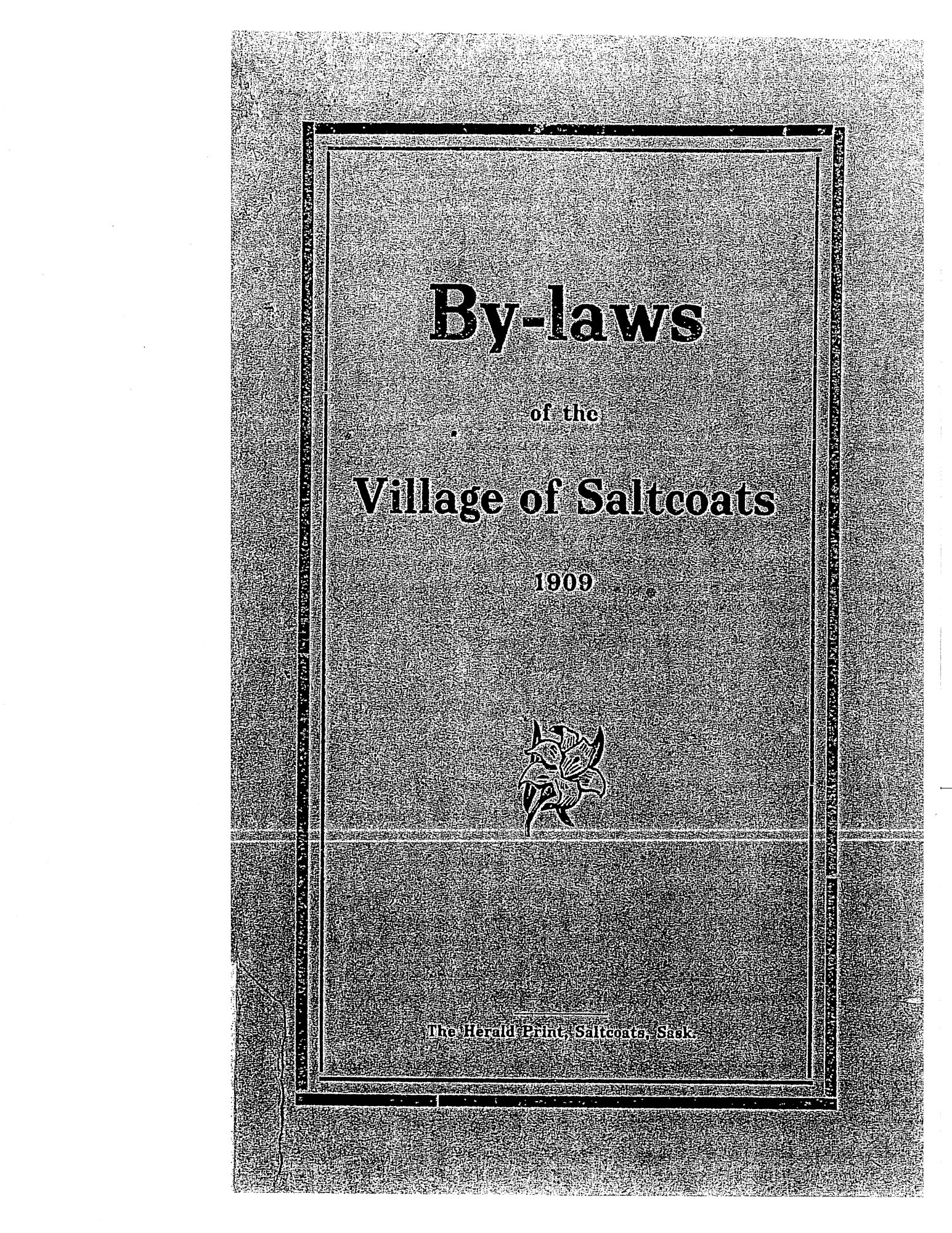
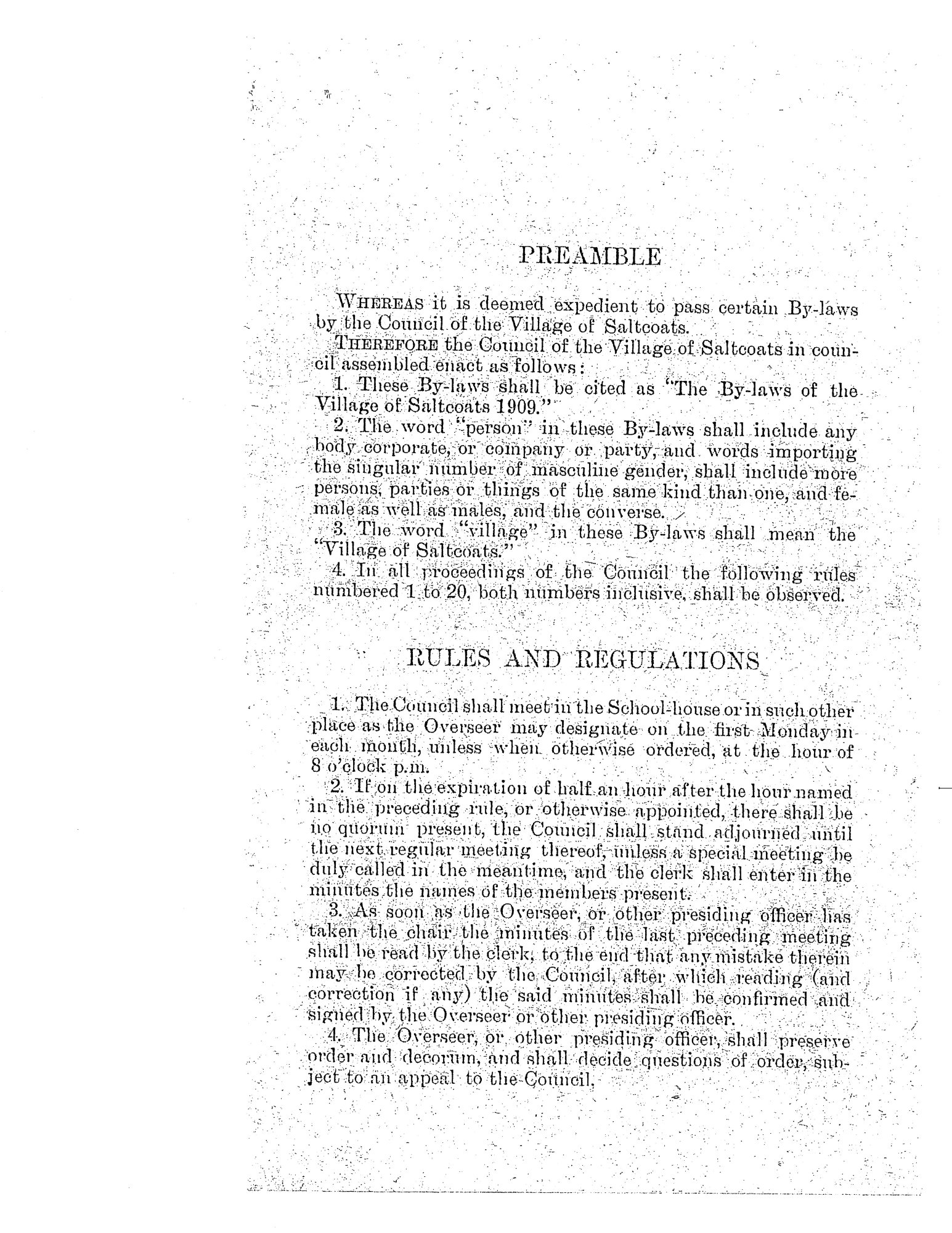
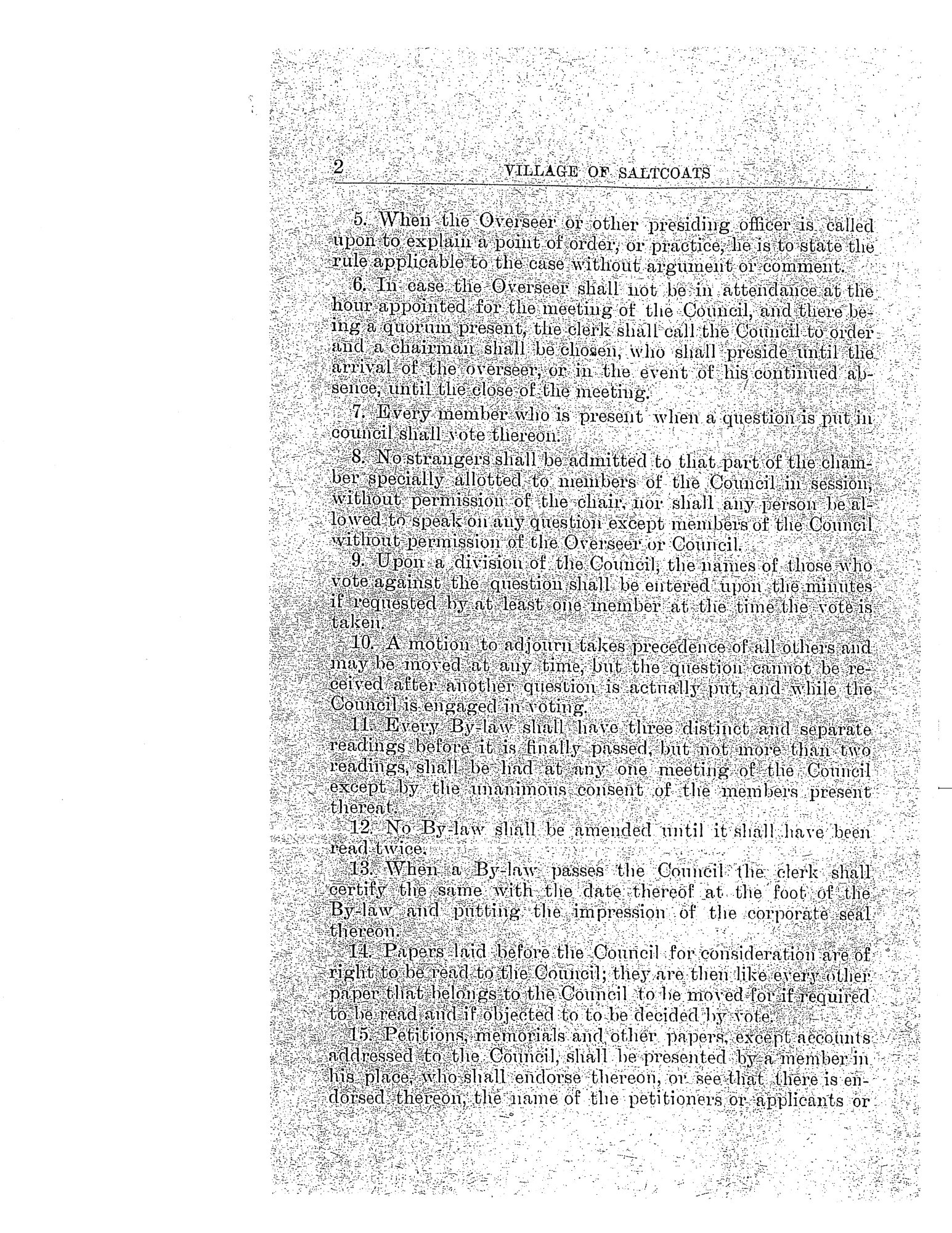
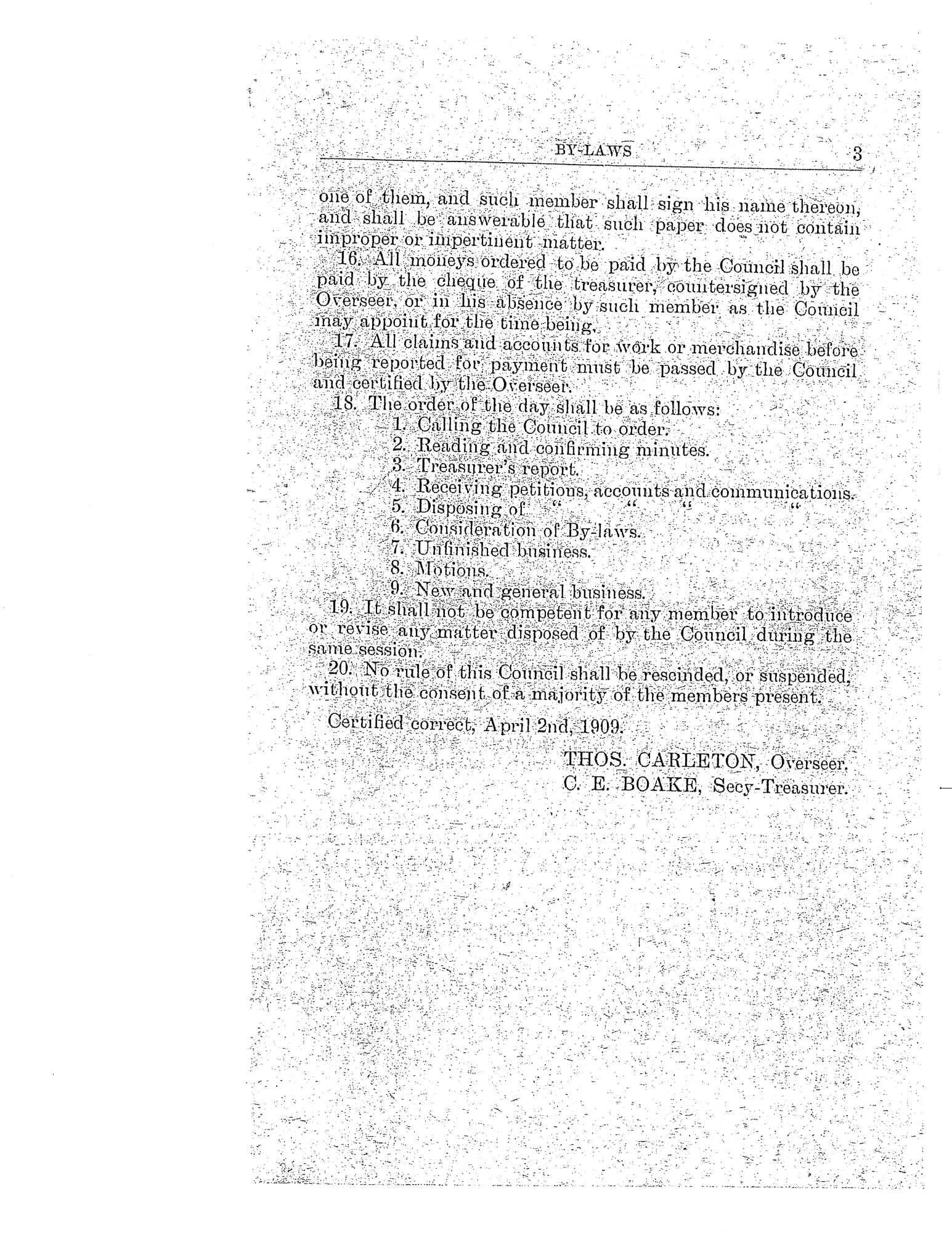
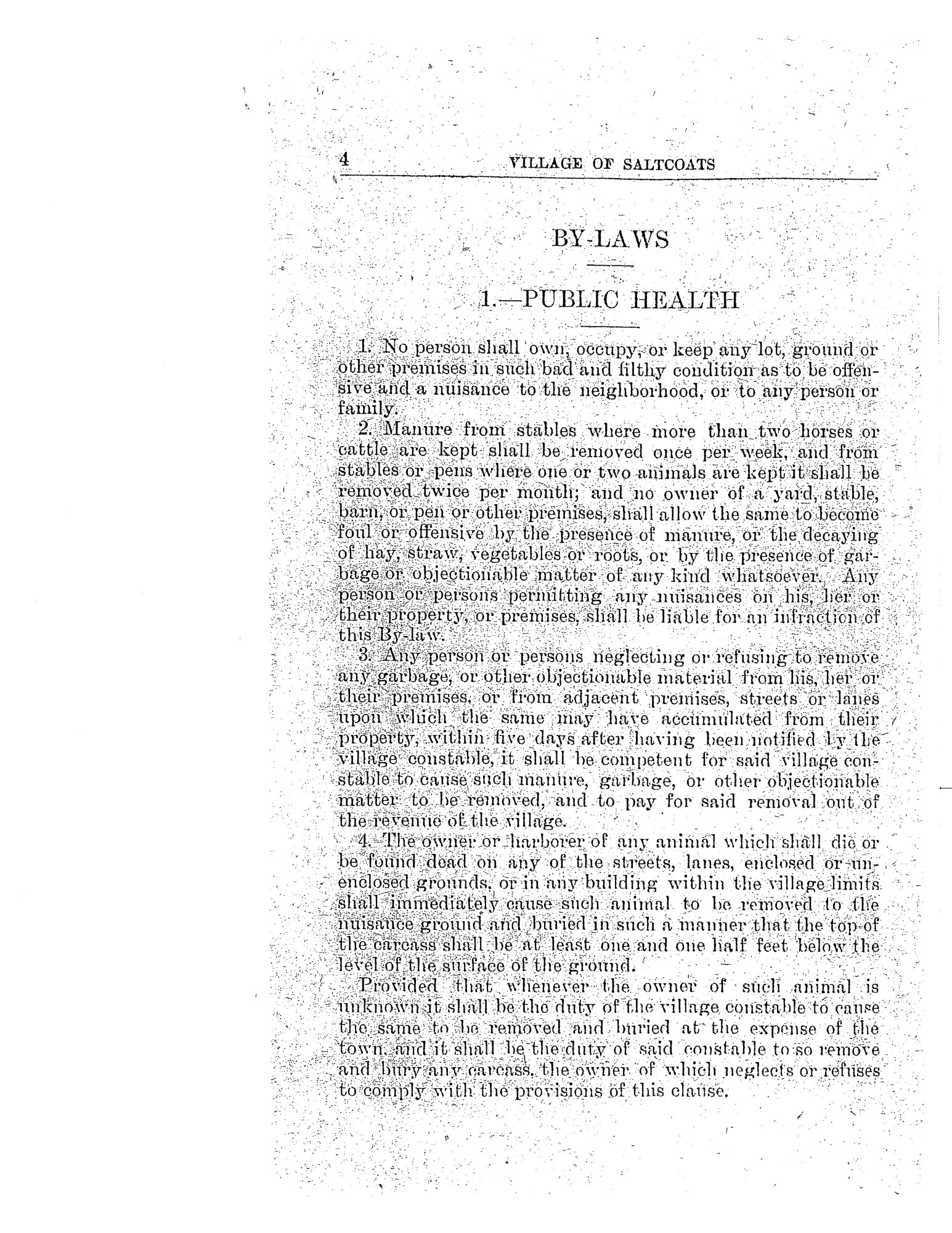















Keep an eye on this section as we continue to share historical highlights, photos, and stories that connect our past to our present.